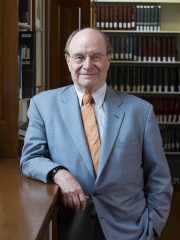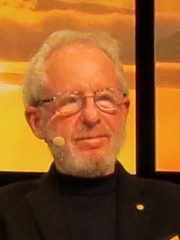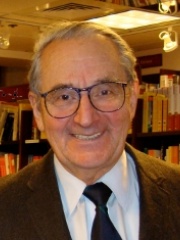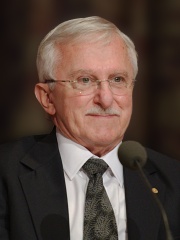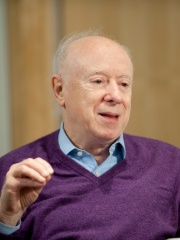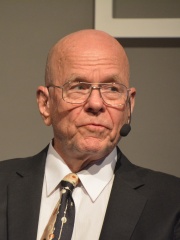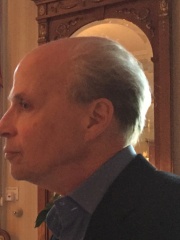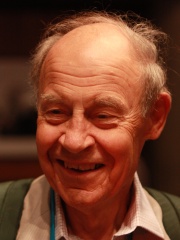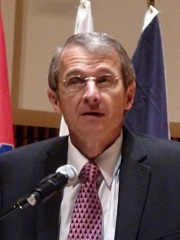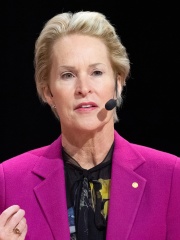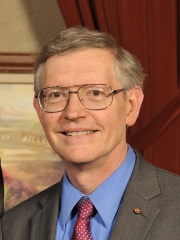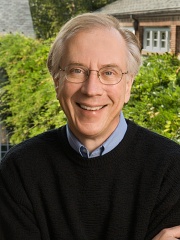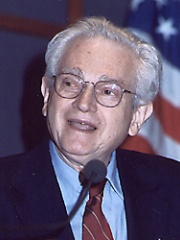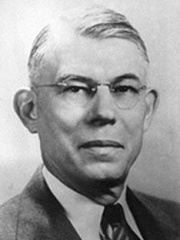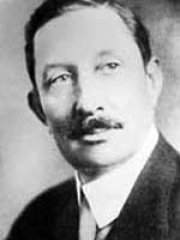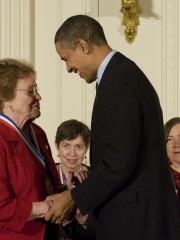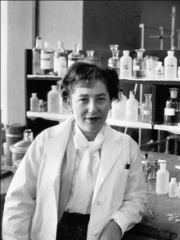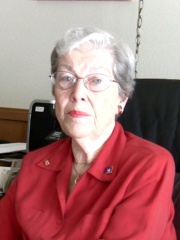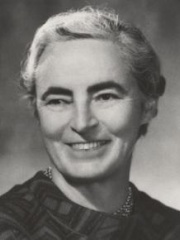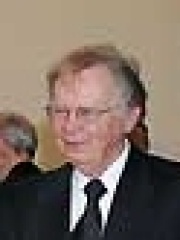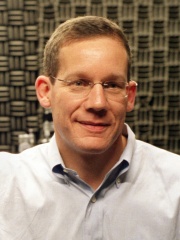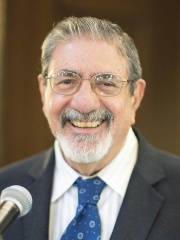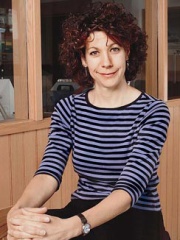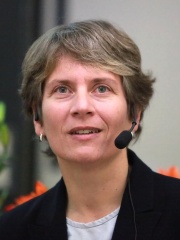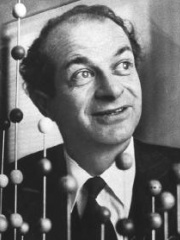
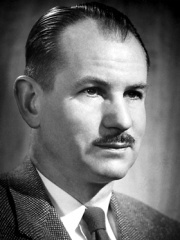
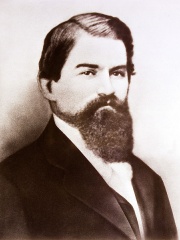
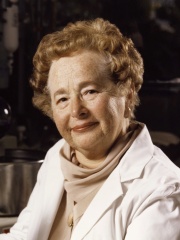
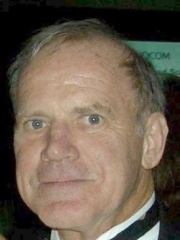
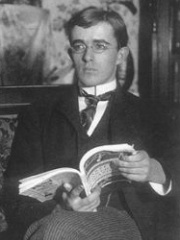
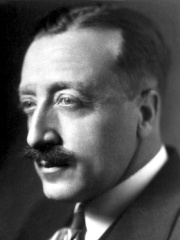
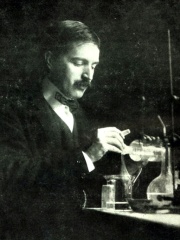
The Most Famous
CHEMISTS from United States
This page contains a list of the greatest American Chemists. The pantheon dataset contains 509 Chemists, 109 of which were born in United States. This makes United States the birth place of the most number of Chemists.
Top 10
The following people are considered by Pantheon to be the top 10 most legendary American Chemists of all time. This list of famous American Chemists is sorted by HPI (Historical Popularity Index), a metric that aggregates information on a biography’s online popularity. Visit the rankings page to view the entire list of American Chemists.

1. Linus Pauling (1901 - 1994)
With an HPI of 73.87, Linus Pauling is the most famous American Chemist. His biography has been translated into 94 different languages on wikipedia.
Linus Carl Pauling ( PAW-ling; February 28, 1901 – August 19, 1994) was an American chemist, biochemist, chemical engineer, peace activist, author, and educator. He published more than 1,200 papers and books, of which about 850 dealt with scientific topics. New Scientist called him one of the 20 greatest scientists of all time. For his scientific work, Pauling was awarded the Nobel Prize in Chemistry in 1954. For his peace activism, he was awarded the Nobel Peace Prize in 1962. He is one of five people to have won more than one Nobel Prize (the others being Marie Curie, John Bardeen, Frederick Sanger, and Karl Barry Sharpless). Of these, he is the only person to have been awarded two unshared Nobel Prizes, and one of two people to be awarded Nobel Prizes in different fields, the other being Marie Curie. Pauling was one of the founders of the fields of quantum chemistry and molecular biology. His contributions to the theory of the chemical bond include the concept of orbital hybridisation and the first accurate scale of electronegativities of the elements. Pauling also worked on the structures of biological molecules, and showed the importance of the alpha helix and beta sheet in protein secondary structure. Pauling's approach combined methods and results from X-ray crystallography, molecular model building, and quantum chemistry. His discoveries inspired the work of Rosalind Franklin, James Watson, Francis Crick, and Maurice Wilkins on the structure of DNA, which in turn made it possible for geneticists to crack the DNA code of all organisms. In his later years, he promoted nuclear disarmament, as well as orthomolecular medicine, megavitamin therapy, and dietary supplements, especially ascorbic acid (commonly known as Vitamin C). None of his ideas concerning the medical usefulness of large doses of vitamins have gained much acceptance in the mainstream scientific community. He was married to the American human rights activist Ava Helen Pauling.

2. Edwin McMillan (1907 - 1991)
With an HPI of 71.13, Edwin McMillan is the 2nd most famous American Chemist. His biography has been translated into 58 different languages.
Edwin Mattison McMillan (September 18, 1907 – September 7, 1991) was an American physicist credited with being the first to produce a transuranium element, neptunium. For this, he shared the 1951 Nobel Prize in Chemistry with Glenn Seaborg. A graduate of California Institute of Technology, he earned his doctorate from Princeton University in 1933, and joined the Berkeley Radiation Laboratory where he discovered oxygen-15 and beryllium-10. During World War II, he worked on microwave radar at the MIT Radiation Laboratory, and then on sonar at the Navy Radio and Sound Laboratory. In 1942 he joined the Manhattan Project, the wartime effort to create atomic bombs, and helped establish its Los Alamos Laboratory where the bombs were designed. He led teams working on the gun-type nuclear weapon design, and also participated in the development of the implosion-type nuclear weapon. McMillan co-invented the synchrotron with Vladimir Veksler, and after the war he returned to the Berkeley Radiation Laboratory to build them. He was appointed associate director of the Radiation Laboratory in 1954 and promoted to deputy director in 1958. He became director upon the death of lab founder Ernest Lawrence later that year, and remained director until his retirement in 1973.

3. John Stith Pemberton (1831 - 1888)
With an HPI of 69.03, John Stith Pemberton is the 3rd most famous American Chemist. His biography has been translated into 48 different languages.
John Stith Pemberton (July 8, 1831 – August 16, 1888) was an American pharmacist and Confederate States Army veteran who is best known as the inventor of Coca-Cola. In May 1886, he developed an early version of a beverage that would later become Coca-Cola, but sold its rights to the drink shortly before his death in 1888. He suffered from a sabre wound sustained in April 1865, during the Battle of Columbus. His efforts to control his chronic pain led to morphine addiction. In an attempt to curb his addiction he began to experiment with various painkillers and toxins. The development of an earlier beverage blending alcohol and cocaine led to the recipe that later was adapted to make Coca-Cola.

4. Gertrude B. Elion (1918 - 1999)
With an HPI of 68.13, Gertrude B. Elion is the 4th most famous American Chemist. Her biography has been translated into 67 different languages.
Gertrude "Trudy" Belle Elion (January 23, 1918 – February 21, 1999) was an American biochemist and pharmacologist, who shared the 1988 Nobel Prize in Physiology or Medicine with George H. Hitchings and Sir James Black for their use of innovative methods of rational drug design for the development of new drugs. This new method focused on understanding the target of the drug rather than simply using trial-and-error. Her work led to the creation of the anti-retroviral drug AZT, which was the first drug widely used against AIDS. Her well known works also include the development of the first immunosuppressive drug, azathioprine, used to fight rejection in organ transplants, and the first successful antiviral drug, acyclovir (ACV), used in the treatment of herpes infection.
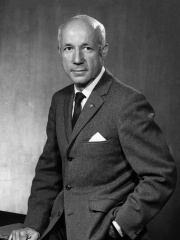
5. Melvin Calvin (1911 - 1997)
With an HPI of 66.42, Melvin Calvin is the 5th most famous American Chemist. His biography has been translated into 61 different languages.
Melvin Ellis Calvin (April 8, 1911 – January 8, 1997) was an American biochemist known for discovering the Calvin cycle along with Andrew Benson and James Bassham, for which he was awarded the 1961 Nobel Prize in Chemistry. He spent most of his five-decade career at the University of California, Berkeley.

6. Kary Mullis (1944 - 2019)
With an HPI of 66.32, Kary Mullis is the 6th most famous American Chemist. His biography has been translated into 53 different languages.
Kary Banks Mullis (December 28, 1944 – August 7, 2019) was an American biochemist. In recognition of his role in the invention of the polymerase chain reaction (PCR) technique, he shared the 1993 Nobel Prize in Chemistry with Michael Smith and was awarded the Japan Prize in the same year. PCR became a central technique in biochemistry and molecular biology, described by The New York Times as "highly original and significant, virtually dividing biology into the two epochs of before PCR and after PCR."Mullis downplayed humans' role in climate change, expressed doubt that HIV is the cause of AIDS, and professed a belief in astrology and the paranormal. Mullis's unscientific statements about topics outside his area of expertise have been named by Skeptical Inquirer as an instance of "Nobel disease".

7. Irving Langmuir (1881 - 1957)
With an HPI of 66.22, Irving Langmuir is the 7th most famous American Chemist. His biography has been translated into 65 different languages.
Irving Langmuir (; January 31, 1881 – August 16, 1957) was an American chemist, physicist, and engineer. He was awarded the Nobel Prize in Chemistry in 1932 for his work in surface chemistry. Langmuir's most famous publication is the 1919 article "The Arrangement of Electrons in Atoms and Molecules" in which, building on Gilbert N. Lewis's cubical atom theory and Walther Kossel's chemical bonding theory, he outlined his "concentric theory of atomic structure". Langmuir became embroiled in a priority dispute with Lewis over this work; Langmuir's presentation skills were largely responsible for the popularization of the theory, although the credit for the theory itself belongs mostly to Lewis. While at General Electric from 1909 to 1950, Langmuir advanced several fields of physics and chemistry, inventing the gas-filled incandescent lamp and the hydrogen welding technique. The Langmuir Laboratory for Atmospheric Research near Socorro, New Mexico, was named in his honor, as was the American Chemical Society journal for surface science called Langmuir.

8. John Howard Northrop (1891 - 1987)
With an HPI of 65.98, John Howard Northrop is the 8th most famous American Chemist. His biography has been translated into 64 different languages.
John Howard Northrop (July 5, 1891 – May 27, 1987) was an American biochemist who, with James Batcheller Sumner and Wendell Meredith Stanley, won the 1946 Nobel Prize in Chemistry. The award was given for these scientists' isolation, crystallization, and study of enzymes, proteins, and viruses. Northrop was a Professor of Bacteriology and Medical Physics, Emeritus, at University of California, Berkeley.

9. Theodore William Richards (1868 - 1928)
With an HPI of 65.79, Theodore William Richards is the 9th most famous American Chemist. His biography has been translated into 57 different languages.
Theodore William Richards (January 31, 1868 – April 2, 1928) was an American physical chemist and the first American scientist to receive the Nobel Prize in Chemistry, earning the award "in recognition of his exact determinations of the atomic weights of a large number of the chemical elements."
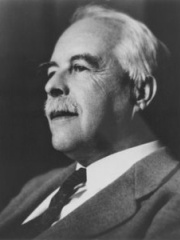
10. Gilbert N. Lewis (1875 - 1946)
With an HPI of 65.62, Gilbert N. Lewis is the 10th most famous American Chemist. His biography has been translated into 55 different languages.
Gilbert Newton Lewis (October 23 or October 25, 1875 – March 23, 1946) was an American physical chemist and a dean of the college of chemistry at University of California, Berkeley. Lewis was best known for his discovery of the covalent bond and his concept of electron pairs; his Lewis dot structures and other contributions to valence bond theory have shaped modern theories of chemical bonding. Lewis successfully contributed to chemical thermodynamics, photochemistry, and isotope separation, and is also known for his concept of acids and bases. Lewis also researched on relativity and quantum physics, and in 1926 he coined the term "photon" for the smallest unit of radiant energy.G. N. Lewis was born in 1875 in Weymouth, Massachusetts. After receiving his PhD in chemistry from Harvard University and studying abroad in Germany and the Philippines, Lewis moved to California in 1912 to teach chemistry at the University of California, Berkeley, where he became the dean of the college of chemistry and spent the rest of his life. As a professor, he incorporated thermodynamic principles into the chemistry curriculum and reformed chemical thermodynamics in a mathematically rigorous manner accessible to ordinary chemists. He began measuring the free energy values related to several chemical processes, both organic and inorganic. In 1916, he also proposed his theory of bonding and added information about electrons in the periodic table of the chemical elements. In 1933, he started his research on isotope separation. Lewis worked with hydrogen and managed to purify a sample of heavy water. He then came up with his theory of acids and bases, and did work in photochemistry during the last years of his life. Though he was nominated 41 times, G. N. Lewis never won the Nobel Prize in Chemistry, resulting in a major Nobel Prize controversy. On the other hand, Lewis mentored and influenced numerous Nobel laureates at Berkeley including Harold Urey (1934 Nobel Prize), William F. Giauque (1949 Nobel Prize), Glenn T. Seaborg (1951 Nobel Prize), Willard Libby (1960 Nobel Prize), Melvin Calvin (1961 Nobel Prize) and so on, turning Berkeley into one of the world's most prestigious centers for chemistry. On March 23, 1946, Lewis was found dead in his Berkeley laboratory where he had been working with hydrogen cyanide; many postulated that the cause of his death was suicide. After Lewis' death, his children followed their father's career in chemistry, and the Lewis Hall on the Berkeley campus is named after him.
Pantheon has 109 people classified as chemists born between 1831 and 1972. Of these 109, 28 (25.69%) of them are still alive today. The most famous living chemists include Walter Gilbert, Alan J. Heeger, and Elias James Corey. The most famous deceased chemists include Linus Pauling, Edwin McMillan, and John Stith Pemberton. As of April 2022, 12 new chemists have been added to Pantheon including Dudley R. Herschbach, Caleb Bradham, and Helen Murray Free.
Living Chemists
Go to all Rankings
Walter Gilbert
1932 - Present
HPI: 60.58
Alan J. Heeger
1936 - Present
HPI: 60.55
Elias James Corey
1928 - Present
HPI: 59.75
Paul L. Modrich
1946 - Present
HPI: 59.19
Joseph L. Goldstein
1940 - Present
HPI: 59.18
Karl Barry Sharpless
1941 - Present
HPI: 58.76
Roger D. Kornberg
1947 - Present
HPI: 58.46
Dudley R. Herschbach
1932 - Present
HPI: 56.82
Richard R. Schrock
1945 - Present
HPI: 55.59
Frances Arnold
1956 - Present
HPI: 55.47
William E. Moerner
1953 - Present
HPI: 54.19
Thomas Cech
1947 - Present
HPI: 53.85

Deceased Chemists
Go to all Rankings
Linus Pauling
1901 - 1994
HPI: 73.87
Edwin McMillan
1907 - 1991
HPI: 71.13
John Stith Pemberton
1831 - 1888
HPI: 69.03
Gertrude B. Elion
1918 - 1999
HPI: 68.13
Melvin Calvin
1911 - 1997
HPI: 66.42
Kary Mullis
1944 - 2019
HPI: 66.32
Irving Langmuir
1881 - 1957
HPI: 66.22
John Howard Northrop
1891 - 1987
HPI: 65.98
Theodore William Richards
1868 - 1928
HPI: 65.79
Gilbert N. Lewis
1875 - 1946
HPI: 65.62
Marshall Warren Nirenberg
1927 - 2010
HPI: 65.31
Edward Adelbert Doisy
1893 - 1986
HPI: 64.32

Newly Added Chemists (2022)
Go to all Rankings
Dudley R. Herschbach
1932 - Present
HPI: 56.82
Caleb Bradham
1867 - 1934
HPI: 47.57
Helen Murray Free
1923 - 2021
HPI: 45.39
Mildred Cohn
1913 - 2009
HPI: 42.62
Darleane C. Hoffman
1926 - Present
HPI: 41.22
Anna J. Harrison
1912 - 1998
HPI: 40.95
Wallace Smith Broecker
1931 - 2019
HPI: 40.59
Charles M. Lieber
1959 - Present
HPI: 40.46
Richard Zare
1939 - Present
HPI: 39.89
Sam Ruben
1913 - 1943
HPI: 36.10
Bonnie Bassler
1962 - Present
HPI: 32.88
Carolyn R. Bertozzi
1966 - Present
HPI: 29.32

Which Chemists were alive at the same time? This visualization shows the lifespans of the 25 most globally memorable Chemists since 1700.

